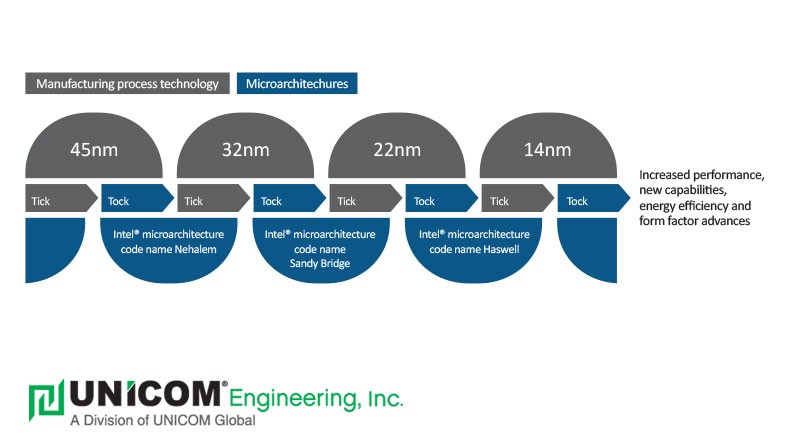Part I of this guide introduced you to the reasons application developers should consider the latest microprocessor technology for their next-gen deployment solutions. Since countless industries utilize Intel microprocessors and plan their upgrades according to Intel’s release schedule, focusing on making your application platform compatible with the latest microarchitecture is crucial. Just as important is understanding how to leverage the full level of potential that Intel’s latest products offer.
Changes to Microarchitecture
While staying abreast of these developments can seem overwhelming, Intel’s predictable product release strategy simplifies it greatly. Keeping up with the upcoming releases is as simple as remembering “Tick, Tock.”
No, we are not alluding to a grandfather clock. Instead, “Tick, Tock” indicates the rhythm of Intel’s alternating migration to more advanced processing technologies and more advanced fabrication processes. If all goes according to plan, Intel will have new versions of chips released roughly on a 2 to 3.5-year schedule. Getting used to this rhythm and what it typically brings can allow your application design to keep pace — or perhaps to even predict microarchitecture changes ahead.
“Tick” - Moore’s Law at Work
The “Tick” part of Intel’s cycle refers to advances in fabrication technology. These advances correspond with smaller chip sizes packed more densely with transistors. Strongly recalling Moore’s Law, these new designs allow for faster, more capable processors in a smaller size and at a relatively low cost. The connection between Moore’s Law and “Tick, Tock” is mostly uncoincidental, too, since Gordon E. Moore was a co-founder of Intel.
One of the most ingenious elements of the “Tick, Tock” strategy is that Intel strongly emphasizes compatibility between the new, smaller processors and their immediate predecessors. Thus, when Haswell recently transitioned from a 22nm node process to a 14nm node process named Broadwell, manufacturers could deploy very similar system architecture — sometimes even the same motherboards — while utilizing the new smaller and faster chips.
“Tock” - True Innovation that Surprises
Following a “Tick” shrinking of processor half-pitch comes a “Tock” redesign of Intel’s processor line. While most of these redesigns incorporate familiar overall microarchitectures — currently offered to consumers in recognizable i3, i5, and i7 product names — the technology built into the processor permits new levels of capability.
For instance, following the “Tick” transition of Nehalem to 32 nm Westmere builds back in 2010, Intel completely redesigned their processors to the Sandy Bridge microarchitecture. This new version, among other features, allows for Hyper-Threading processing that utilizes separate cores in dynamic ways to increase processing speed even under heavy loads.
After another “Tick” to 22nm Ivy Bridge processors, a “Tock” release of Haswell with DDR4 support and other features debuted. Then, like clockwork, a “Tick” shrinking of Haswell to 14nm was released, dubbed Broadwell.
Sinking into the Tick Tock Rhythm
Understanding the logic and cadence of such a release schedule is crucial for software application developers who want to be able to offer the latest performance capabilities to their customers. UNICOM Engineering has nearly two decades of helping its clients to navigate and streamline the transition to next-generation Intel microarchitecture. Between Intel’s predictability, our expertise, and your diligent research, your application can be destined for great things. who
